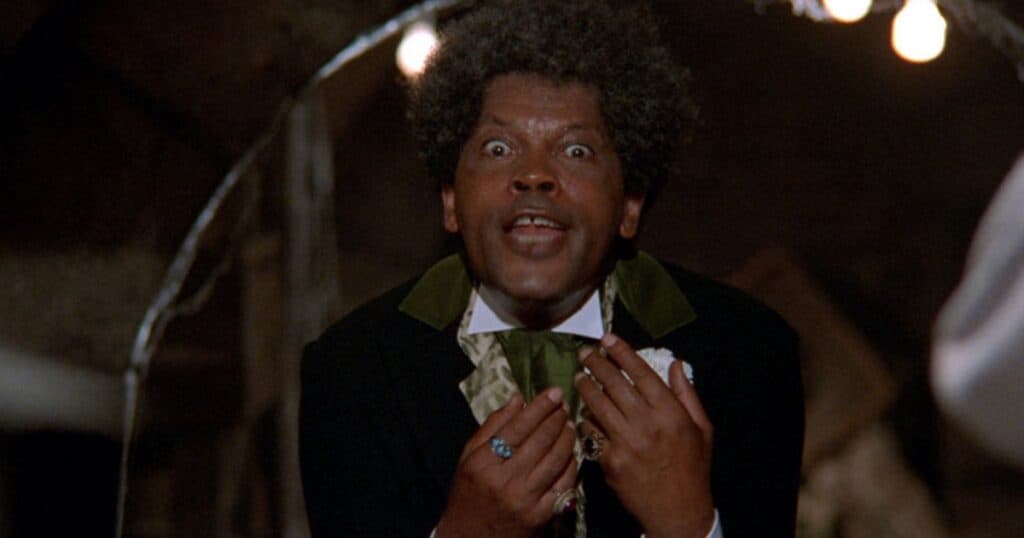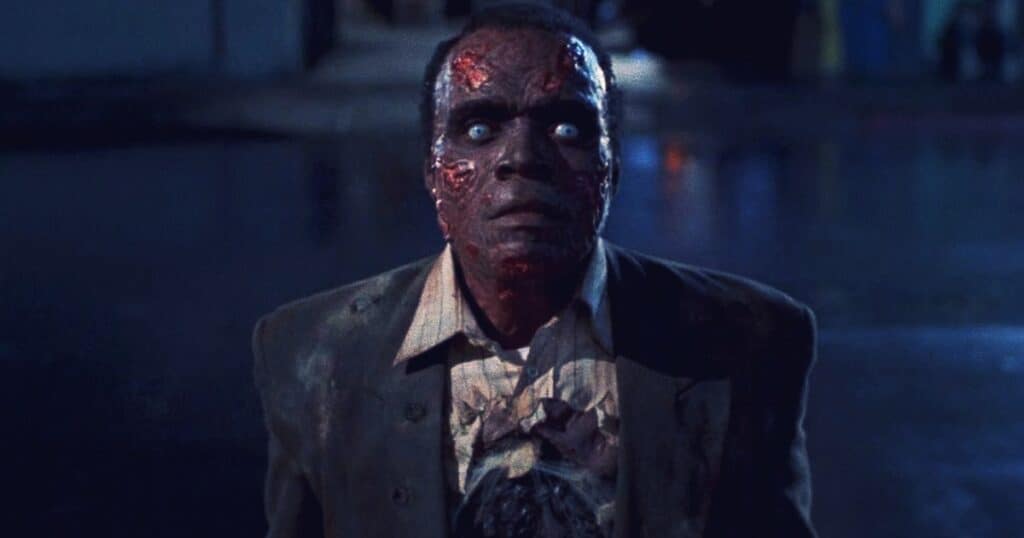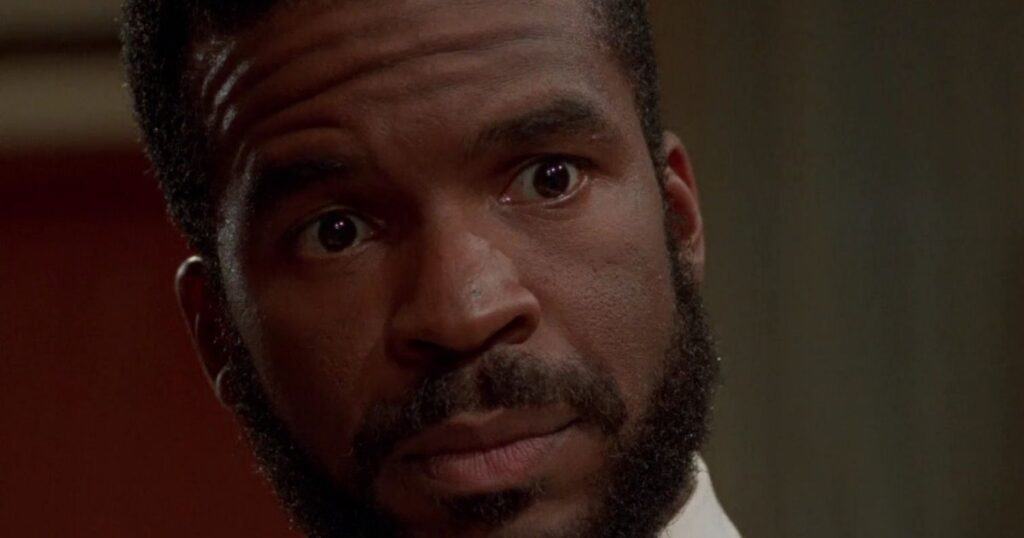The episode of The Test of Time covering Tales from the Hood was Written by Andrew Hatfield, Narrated by Niki Minter, Edited by Mike Conway, Produced by John Fallon and Tyler Nichols, and Executive Produced by Berge Garabedian.
For the most part on this show, we are looking at certified classics to see if they still hold up. For the most part, anyway. Looking at you C.H.U.D. We try to look at everything from the cinematography and direction to the acting and special effects. Sometimes though the story ends up being the most important aspect of the movie. Every now and then a movie needs a reappraisal even when it wasn’t a hit at the time or seen as a classic. Look at what happened to The Thing. From box office dud (even though that has been blown out of proportion) and critical hatred to topping a lot of people’s lists of best to ever be. Spoiler alert, today’s movie not only stands the Test of Time but at parts is far more prescient today than when it was released nearly 30 years ago. Sit back and try to relax as we tell you some Tales from the Hood (watch it HERE).
Plot
The anthology film is a popular, yet often flawed, sub-genre within horror. It’s been around for over 100 years with the German made Uncanny Stories being released in 1919 but really hit its stride in the 60s and 70s courtesy of Hammer Films’ chief rival, Amicus films. Founded by Milton Subotsky and Max Rosenberg, Amicus made a couple Doctor Who films starring Peter Cushing as well as a few other movies to capitalize on the sci-fi or horror trends of the time, but they are remembered for their anthologies. I’d be mad at myself for not naming a couple of my favorites with Dr. Terror’s House of Horror and Tales from the Crypt, but you mostly can’t go wrong… mostly. That’s really the only caveat with anthology movies, there is usually one or two that fall flat.

Anyway, the idea for Tales from the Hood came from eventual director Rusty Cundieff and his one act play called The Black Horror Show: Blackanthropy. He was approached by producer Darin Scott to make a movie and he agreed, though he wanted it to mean something. He didn’t just want to make a movie to make a movie. The anthology format allowed them to tell multiple stories they found important to them, and the title is an obvious homage to Tales from the Crypt, both the 1972 movie and the EC comics it was based on. The 4 stories they put together are “Rogue Cop Revelation”, “Boys Do Get Bruised”, “KKK Comeuppance”, and “Hardcore Convert”, with the always important wraparound story of “Welcome to my Mortuary.” This was not Cundieff’s first movie as two years before he released a mocumentary called Fear of a Black Hat. After the success of Tales from the Hood, it made just under double it’s budget by the way, Rusty would go on to be one of the bigger TV directors you don’t know. He did 25 episodes of Chapelle Show, a ton of episodes of The Wanda Sykes Show, and kind of came full circle with a couple episodes of Creepshow for Shudder. He would also direct the two sequels to today’s movie with Tales from the Hood 2 and Tales from the Hood 3.
His writing partner and producer Darin Scott would have a lot more hits before Tales, being a producer on Menace II Society, Best Horror Anthology You Never Saw From a Whisper To a Scream, and Black Sheep favorite Stepfather 2. As a director he would helm anthology flick American Horror and Deep Blue Sea 2 and he would write Whisper to a Scream and the first 2 Tales movies. The in front of the screen talent has some great character actors like Duane Whitaker and Michael Massey, a few more recognizable talents like Corbin Bernson, David Alan Grier, and Wings Houser, and then a bunch of up and coming talent like Deandre Bounds, Joe Torry, and Samuel Monroe Jr. Then there is Clearance Williams III who, spoiler alert, is our crypt keeper and is in a class of his own.
The stories follow corrupt cops who work outside the law, child abuse and how it’s seen from all angles, casual and overt racism in a public office, and gang violence through the lens of accountability. These stories are bookended by a drug pickup in a mortuary where, in classic style, the people hearing the stories are being introduced to a hell of their own making. It made 11.8 million on it’s 6 million dollar budget and had split critical reception even though it has become a cult classic and standout amongst the anthology format. It finally received a Blu-ray from Scream Factory in 2017 that is a must own.

Sign of the Times
Blaxploitation is actually a beloved and groundbreaking section of film that has had a resurgence in the last few years but started in earnest in 1968 with Uptight, a remake of John Ford’s The Informer from the mid 1930s. The 70s is when it hit its stride with things like Sweet Sweetbacks Badassssss Song, Shaft, and Blacula. As you can see, it’s not just horror and Blaxploitation can cover a huge range of subjects like gangster, crime, drama, musical, comedy, and nearly everything else. The point of the movement was to shine a positive light on Black characters, being the hero or antihero of the movie and pushing against what Hollywood had painted black actors and characters for years and put them into roles that many producers just flat out wouldn’t for years. I would also like to point out that this isn’t the first Blaxploitation Anthology film as Tales from the Quadead Zone came out in 1987
It made a resurgence in the late 80s with gems like I’m Gonna Git You, Sucka! and Action Jackson and continued into the mid to late 90s with today’s film as well as Original Gangtas and, to a degree, Jackie Brown. That wasn’t the only style to focus on Black culture as movies like Friday and House Party aimed at comedy with a dose of realism and Menace II Society, Boyz n the Hood, and New Jack City looked at drugs, crime, and life growing up with no choice. While Candyman and Eve’s Bayou went the straight horror route, Tales from the Hood took many of the situations that the dramatic movies were focused on and put them through the view of a horror movie.
Another very real sign of the times are the very themes the movie deals with. Black on Black crime and police brutality were, and are, very big topics. The movie does a remarkable job not just trying to play the blame game and instead attempting to show fault at all sides. Sadly, many of these things continue today in a world of social media and everyone having a full video camera in their pocket.
What Holds Up?
A ton here is really astonishing to watch. In addition to the prescient nature of the stories involved, they are just really well told. Yes, as I stated before, there is usually one less than memorable story and in this case it’s the 4th one, but the first three and wraparound tale knock it out of the park. The first story about police officers killing an activist who is trying to oust the crooked cops from the department adds the twist of the African American cop seeing and knowing what’s about to happen, but not doing anything to stop it. It goes further though as that officer does not get off Scott free, regardless of what color he is. The second story still has the best interpretation of child abuse I’ve ever seen with David Alan Grier’s abusive father being seen from the childs point of view as an ACTUAL monster. The third story has the antagonist being killed by a symbol of the people he hates and diminishes while the final story shows how hard it is to end a cycle of violence.

Another thing that stands up quite well is the special effects… non-CGI division. I had no idea until this watch and research that many of the special effects were done by the famous Chiodo brothers’ studio but that tracks. From the mangled but still living body of a child beating father to the revenge seeking doll people that would creep anyone out, almost all of the practical effects look great. That’s the thing about practical effects, they almost always age well while CGI tries to out do itself and sometimes the millions and millions of dollars that go into them give off a bland or even gross look. More on that later though. Even some of the “guy in a rubber suit” effects are used in a way that makes the scene pop and add to the feel of the overall movie.
Finally, there is one performance that stands head and shoulders above the rest. While Clearance Williams III is stellar as our host and has some of the most outrageous facial expressions or lines in the film, its David Alan Grier that will stay with you long after. He is in over 120 different TV shows and movies with his most famous roles being either as part of the stellar cast of In Living Color or, if you are that age, as the cop in Jumanji. He has done a lot of comedy, a few action films and dramas but only 1 horror film and boy, are we worse off because of that. His turn as the abusive father and husband, a story that the director based off of a real-life experience, is beyond chilling. I would love to see him play a serial killer or main villain in a horror movie or action flick. He is menacing and I don’t ever want to run into anyone like him.
What doesn’t hold up?
Effects can be a double-edged sword. 1995 wasn’t exactly the pinnacle for CGI and while it isn’t as egregious as some of the movies we’ve talked about on this channel, the devil tongue that comes out of the morticians’ teeth looks like an early build of something out of Who Framed Roger Rabbit and not in a good way. Quickly following this is the main trio ending up in hell and yeah, it looks like a school production. It’s a shame as we JUST discussed how cool this movie looks but these, especially happening at the end, are a letdown.
David Alan Grier aside, the acting isn’t anything to write home about either. With veterans like Corbin Bernsen and Clearance Williams III chewing the scenery, it makes many of the other performances stand out and not for the right reasons. This doesn’t ruin the movie by any means but it’s noticeable enough from a handful of main characters to be distracting and really take away from these meaningful tales.
Verdict
This is a no-brainer. Tales from the Hood has aged like fine wine. Not only is it an above average anthology movie that hits on almost every story, but its themes and warnings are just as important today as they were in the mid-90s. It is a rare horror movie that has a clear message and doesn’t pull any punches. It was impressive enough that Spike Lee wanted in on the producer side and he’s another one that doesn’t really attach himself to horror. The fun homages like the doctor in the 4th story being named Cushing, as in Peter, one of the kings of the Amicus Anthologies, or the dolls being cousins to the Zuni Fetish doll from Trilogy of Terror add a charm while paying respects to the films that inspired it. Check this one out if you ae new to it or it’s just been a while as Tales from the Hood more than stands the Test of Time.
A couple of the previous episodes of The Test of Time can be seen below. To see more, click over to the JoBlo Horror Originals YouTube channel – and subscribe while you’re there!
The post Tales from the Hood (1995) – The Test of Time appeared first on JoBlo.
No comments:
Post a Comment